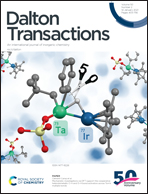Engineering ligand conformation by substituent manipulation towards diverse copper–tricarboxylate frameworks with tuned gas adsorption properties†
Abstract
To expand the structural diversity and optimize the material performance, it is essential but challenging to regulate MOF structures in a predictable and controllable manner. In this work, by manipulating the substituents to engineer the ligand conformations, we designed and synthesized two asymmetric tricarboxylate ligands, and used them to successfully target two copper–tricarboxylate frameworks with diversified topologies depending on the ligand conformations. Besides, the ligand asymmetry induced the formation of two uncommon kinds of copper–carboxylate clusters, thus greatly expanding the library of copper–carboxylate secondary building units. Furthermore, the two compounds also displayed tunable gas adsorption properties pertinent to C2H2 separation and purification. At 298 K and 1 atm, the uptake capacity of C2H2 varies from 79.5 to 104.6 cm3 (STP) g−1, while the adsorption selectivities of C2H2 with respect to CO2 and CH4 are in the range of 2.3–3.8 and 15.3–21.6 for the equimolar components, respectively. Compared to the nitro counterpart, the methoxy MOF features higher C2H2 uptake capacity, larger C2H2/CO2 and C2H2/CH4 adsorption selectivities, and lower regeneration energy. This work demonstrates that simple ligand modification can be used to engineer the structures and tune gas adsorption properties of the resulting MOFs.



 Please wait while we load your content...
Please wait while we load your content...